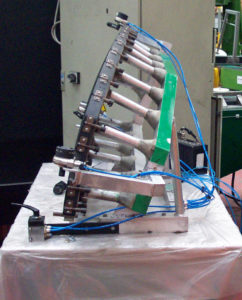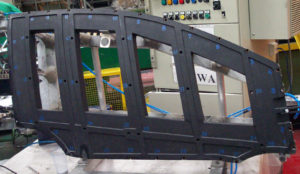Philtec has partnered with the Italian company Technosens to provide the complete turnkey solution for automatic production lines. The method used is to compare a production piece glass shape to the shape of a master frame as shown here.
The production line glass is placed against the master frame, and Philtec’s non-contact sensors measure distance to the glass at 50 locations. With data from 50 sensors, the shape of the glass is accurately mapped. Philtec’s non-contact optical sensors provide a scratch-free solution that is ideal for thin glass, where contact gages such as LVDTs can move and distort the glass when applied via air pressure.
With Technosens equipment, each measured piece has a complete traceability and the production is real time monitored with advanced statistics on process, moulds, system analysis (SPC, MSA) to have the maximum reduction of discarded pieces.


